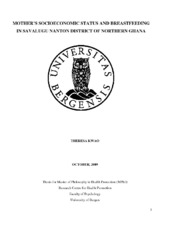| dc.description.abstract | PURPOSE: The aim of this research is to identify socioeconomic factors associated with mother's breastfeeding infants from 0-6months old in Savalugu Nanton district of Northern Ghana. Although many previous studies have focused on socioeconomic factors such as occupation, education and breastfeeding, much has not been done to tackle other factors including distance to primary fuel source, room density and their relationship with breastfeeding. Most of the recommendations from previous studies do not reflect local interest. Accordingly, this study is designed to address some of these gaps and focus more on local needs. METHOD: The Study is based on a survey conducted in Savelugu-Nanton of Northern Ghana in 2001 by the United Nations Children's Emergency Fund (UNICEF), the International Food Policy Institute (IFPRI) and the University for Development Studies (UDS). One thousand six hundred and eighty- four households in sixty- four communities participated in the survey. The sample for the survey was 1588 children. Standardised and structured questionnaires were used in the survey. The questionnaire provided information on demographic characteristics, food consumption, socioeconomic factors, nutritional status, social support, household feeding practices, health of index child and community infrastructure. The standard multiple regression analysis was performed to determine the contribution of each of independent variables to the variance in the dependent variable. RESULTS: The results of this study indicate that breastfeeding correlated with number of food groups consumed and also with compound cleanliness. However there was no correlation between breastfeeding and most of the socioeconomic variables. This implies that the socioeconomic factors in this study are not important in predicting breastfeeding in Savalugu Nanton district of Northern Ghana. CONCLUSION: The current study showed a relationship between breastfeeding and compound cleanliness and also with number of food groups consumed. Most of the socioeconomic factors did not correlate with breastfeeding. This does not mean that other socioeconomic factors are not important to predict breastfeeding. Previous studies in western countries and inter-country studies in Africa have indicated a significant relationship between breastfeeding and socioeconomic factors such as occupation and education. It is therefore important that future studies in Savalugu Nanton district of Northern Ghana determine socioeconomic factors appropriate to predict breastfeeding and for that matter the health of the child. In a very poor area like Savalugu Nanton, socioeconomic factors may not only influence breastfeeding. Future research should therefore consider infrastructure and social amenities and their relationship with breastfeeding. | en_US |
